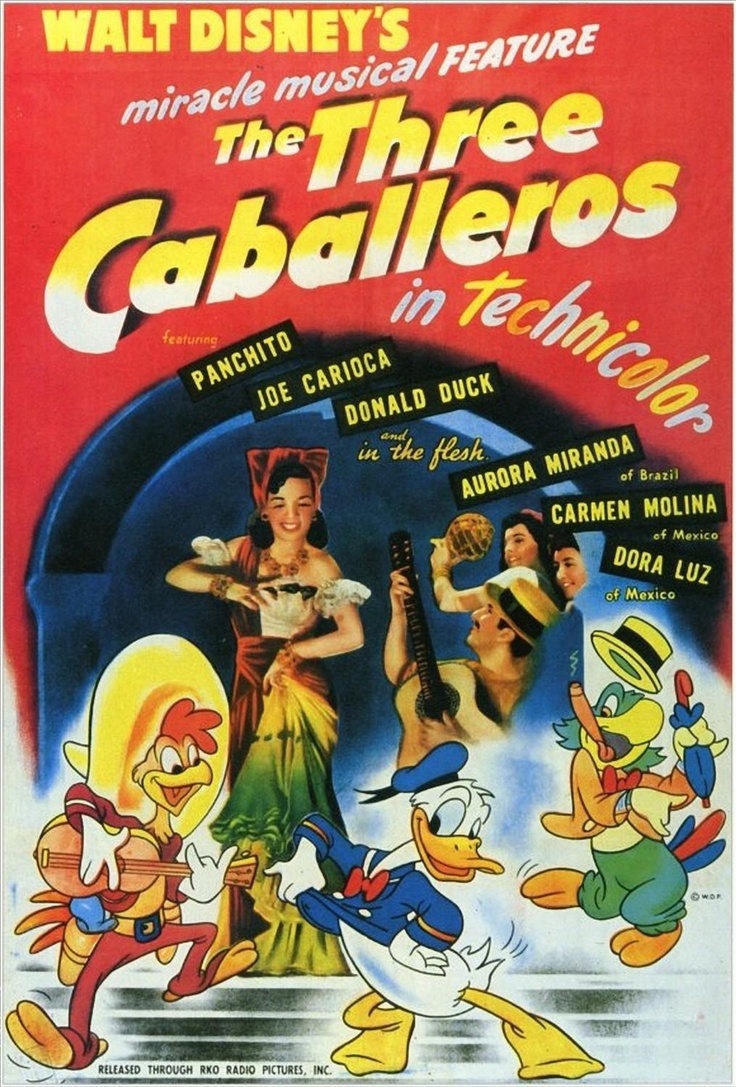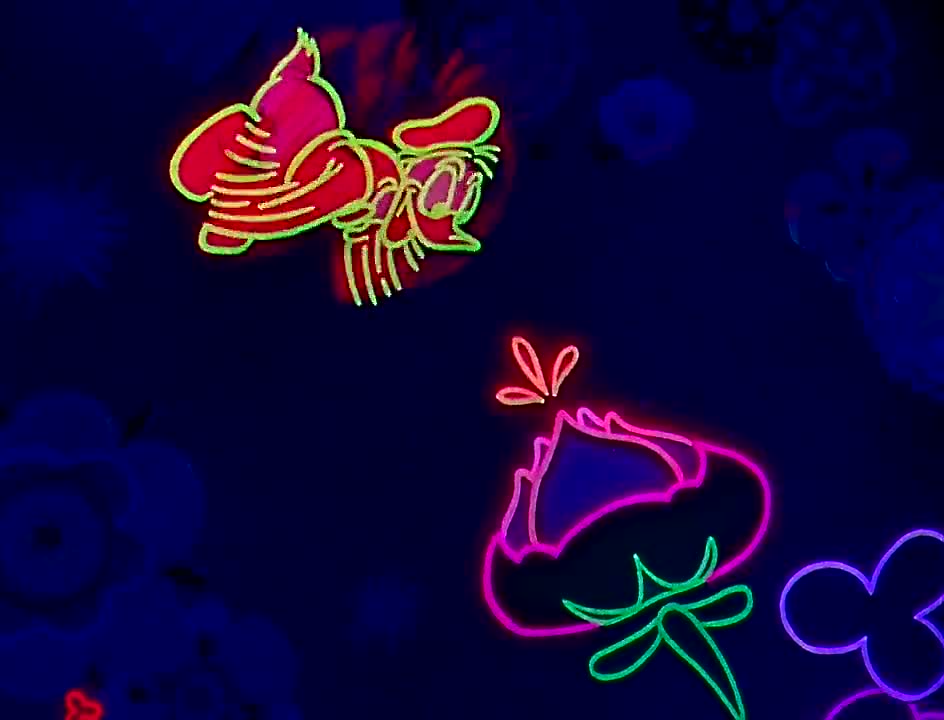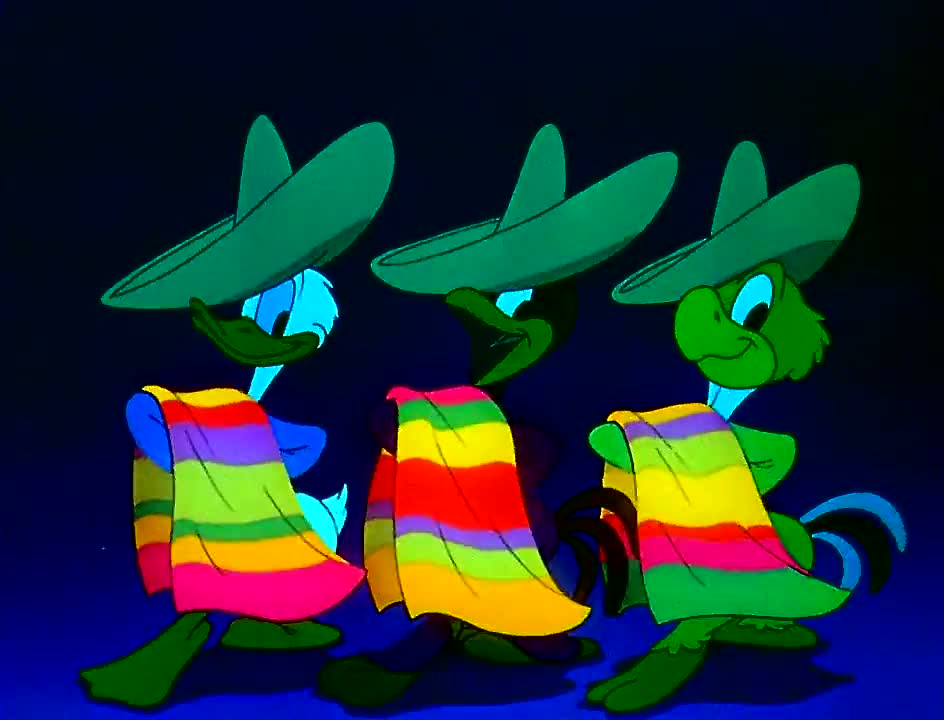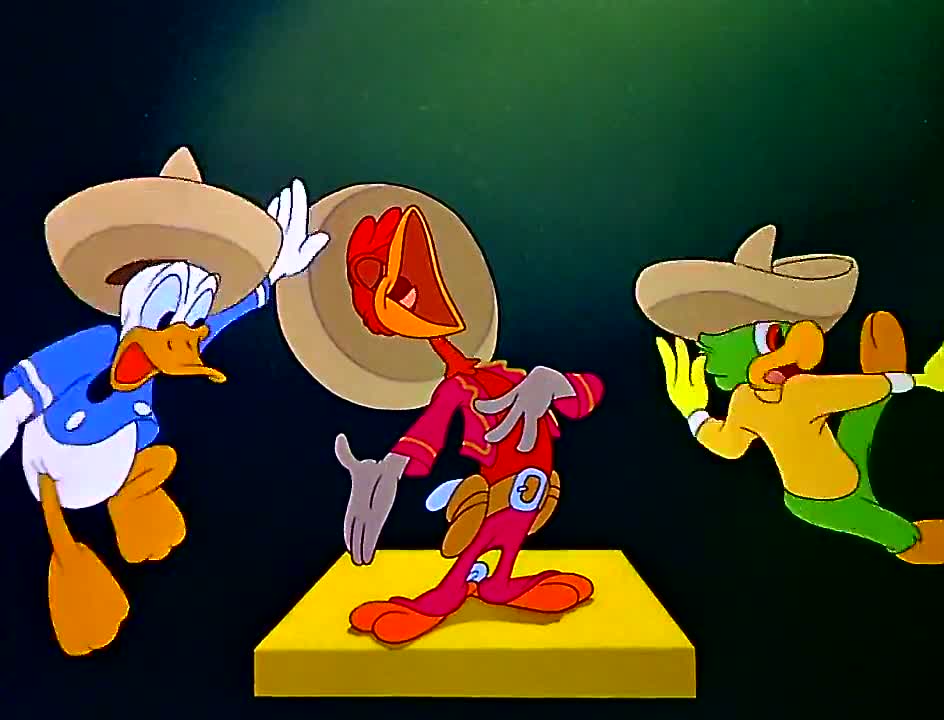1944: The Three Caballeros
 Sunday, October 29, 2017 at 8:21PM
Sunday, October 29, 2017 at 8:21PM by Tim Brayton
 We're celebrating the cinema 1944 right now at the Film Experience, and as the resident animation lover, how could I pass up the chance to take a look at that year's most wonderfully bizarre cartoon? I'm referring to Disney's The Three Caballeros, the studio's second feature-length contribution to the United States government's Good Neighbor policy during World War II. That program involved goodwill tours and films tailor-made for Latin American audiences, and in Disney's case, a combination of both: a research trip to South America with Walt Disney and several of his most important artists result in the creation of 1942's Saludos Amigos, in which international icons Donald Duck and Goofy had fun visiting Brazil and Argentina, respectively, and learning all about the locals.
We're celebrating the cinema 1944 right now at the Film Experience, and as the resident animation lover, how could I pass up the chance to take a look at that year's most wonderfully bizarre cartoon? I'm referring to Disney's The Three Caballeros, the studio's second feature-length contribution to the United States government's Good Neighbor policy during World War II. That program involved goodwill tours and films tailor-made for Latin American audiences, and in Disney's case, a combination of both: a research trip to South America with Walt Disney and several of his most important artists result in the creation of 1942's Saludos Amigos, in which international icons Donald Duck and Goofy had fun visiting Brazil and Argentina, respectively, and learning all about the locals.
Saludos Amigos is a charming, slight movie (at 42 minutes, it severely tests the definition of the term "feature film"), and exactly what you'd anticipate from the description "the U.S. government paid Disney to make a film about how great people in South America are, in the fumbling, patronizing manner of 1940s Hollywood".
Its quasi-sequel is not that at all...

The Three Caballeros is the most openly deranged project ever completed by the Disney animators during Walt Disney's life: the phrase "head trip" didn't exist yet in 1944, but that's largely what we've got here. It's tempting to wonder if the animators' fact-finding trip included mescal and peyote when they weren't busy sketching local costumes.
There's already plenty of that in the narrative, assembled out of several more-or-less connected short segments, as Donald reconnects with his Brazilian parrot friend José Carioca, and the two travel into a book to visit Brazil. Later, Donald inflates himself through some rubbery distortions of his body in order to travel to Mexico. There, the two birds meet the gun-wielding rooster Panchito, who attempts to teach them about the important religious and cultural traditions of Mexico while Donald chases live-action human women before having a complete break from reality as he begins hallucinating Mexican design elements in unearthly colors.
The only thing Disney animation, or mainstream American animation writ large, had ever done like this prior to 1944 was the disorienting drunk scene from Dumbo back in 1941. That scene was only a couple of minutes long. Very nearly half of The Three Caballeros is spent in what I can only think to call surrealism, or the best approximation that commercial American artists in the '40s would dare to come to surrealism.
Nowhere is this more open and exciting than in the titular musical number, a sequence designed and mostly animated by Ward Kimball, one of the only members of the Disney staff who was routinely able to get away with doing the really edgy, demented stuff that the boss hated and stamped out whenever he saw it. Years later, Kimball would speak of the assignment as being dumped on his lap, with no explanation, so that his strategy was simply to illustrate the words in the lyrics – when the characters say "serapes", serapes appear in the visuals. But not just any serapes: bright day-glo serapes as they'd appear under a backlight.

Again, head culture didn't exist yet, but part of me wonders if The Three Caballeros didn't somehow will it into existence
The whole sequence is one of the masterpieces of character animation in the '40s, showcasing a wide range of movements and exaggerated expressions and poses. It's something of a pure playground of color, shape, and absurd gags, all of it set against a featureless background void. It's one of the few exercises in animation for animation's sake to be found anywhere in Disney after the mid-'30s; this kind of physically flexible animation involving quick snaps into place, the manipulation of seemingly boneless characters, and an overall disregard for physics was common in the more slapstick-driven comedy where Disney and other studios had made their name in the '20s and up through around 1933, but by this point in time, Disney's focus was on increasing realism and a much gentler sense of humor. "The Three Caballeros" as a sequence is closer in spirit to the anarchic physical comedy of the Looney Tunes over at Disney's competitor Warner Bros.

And The Three Caballeros as a film isn't close to anything else that was being made at the time: the enormously bright and bold visuals throughout this film, and the surrealist mania of what's being depicted, have a demented, anti-social edge that's even more bizarre given that this was, ultimately, a piece of wartime propaganda. It's easily the strangest animated feature of the 1940s and the most aggressively modern. As a result it's still fresher, after more than 70 years, than cartoons half its age.
 Colorology,
Colorology,  Disney,
Disney,  Mexico,
Mexico,  Oscars (40s),
Oscars (40s),  animated films
animated films 


Reader Comments (4)
One of my weird favorite films. Donald Duck is one of my favorite cartoon characters which definitely helps.
My 1.5 child was crazy about this film. Well, not this film as much as the strech from "Ya Ya" to the titular song. To this day, my wife and i will go "she sells cookies. cookies my friend" to the amusment of no one but us.
As for the film - well, there are some great animation in it, but Donald is a real creep in this film which affects the enjoyment of the film. And even if we say "well, ducks in the 40s will be ducks in the 40s"... why are you chasing human women, Donald? what's the beastiality angle?
Weird movie. Such a weird movie.
Just want to say I LOVE Donald Duck and the currect Ducktales reboot is brilliant. That's all.
Funny. I was just thinking about this movie even though I’ve never seen it. I was at Epcot and there was a ride dedicated to this movie (of course there was) in the Mexico-themed land. It was nice as a break from the heat but I also saw it as soon-to-be replaced by a Coco ride. Now that I know that half the movie was drug-trippy I am so disappointed by the ride that could have been! Thanks for the write up, I sort of want to see this now.